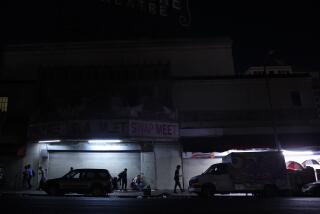Bringing L.A.’s alleys out of the shadows
At the southern tip of Los Angeles, stashed behind railroad cars and fuel depots, is a pillbox of a community center called Mahar House.
Inside, there is a tiny library for kids, with titles by C.S. Lewis and a biography of Paul Revere. In a classroom down the hall, equations used to teach parents the value of building credit are on a chalkboard. In the front room, volunteers give away food they’ve rescued from markets that were going to throw it away.
It’s the kind of place you root for.
Behind it, almost inevitably, is the kind of place you try to avoid.
The alley smells like urine and is lined with cinder-block walls, some topped with razor wire that catches stray plastic bags on windy days. Brown weeds hide a strange array of items: a sock, a broken string of cheap, plastic beads. Someone has dumped a sagging, torn armchair and a filthy mattress.
Men stash stolen cars there, with wires poking out where the stereos used to be, but that’s not the worst of it, said Paula Juarez, who raised two daughters here in Wilmington. Others have been caught peering into apartments, she said. The other day, one tried to talk a 5-year-old girl into taking her clothes off.
The alley, like so many others in L.A., is the scourge of the neighborhood. But a growing coalition of researchers, urban planners, public land advocates and government leaders say it doesn’t have to be that way. Alleys, they argue, could offer enormous environmental and public health benefits -- if they could be turned green.
The alley, long maligned and neglected, is enjoying something of a comeback.
Urban designers who spend their days envisioning cities of the future have begun reincorporating alleys into developments. That’s largely so they can banish garages to the back of lots in order to build more porches and yards out front -- to foster more interaction between residents and the streets they live on.
Older alleys, meanwhile, are undergoing a face-lift. The seeds of the Los Angeles alley campaign were planted elsewhere in recent years: in Seattle, for instance, where alleys have been overhauled to reduce polluted runoff; in Baltimore, where they’ve been rebuilt as pocket parks to combat crime.
But there are few cities whose alleys offer more possibility than Los Angeles. The USC Center for Sustainable Cities, which is leading the alley campaign here, found recently that there are 12,309 blocks of alleys in the city -- 914 linear miles’ worth, roughly the distance between here and Portland, Ore., even if some are just 10 feet wide.
Particularly in older, poorer neighborhoods, where many of them are located, alleys are often dens of crime and blight. But the researchers see something else. They see, all told, more than three square miles of underused land -- about half the size of Griffith Park -- a precious resource in a region starving for vacant land and public space.
They propose lifting ideas from cities such as Seattle and Baltimore while incorporating new ideas to create the most innovative alley overhaul yet: ribbons of eco-friendly, civic-minded spaces coursing through neighborhoods like a spider web.
The new alleys would not all look the same, not by a long shot.
Some would be merely torn up, their old-fashioned concrete replaced with newfangled, permeable material. That would help absorb runoff and reduce the “heat island effect” -- the way the city’s asphalt retains the heat long after the sun has set.
Other alleys could see a more substantial makeover, said Jennifer Wolch, a USC professor of geography and urban planning and the director of the Center for Sustainable Cities, which has conducted a detailed audit of hundreds of alleys.
Some would see their concrete floors replaced with the equivalent of a “Hollywood driveway” -- two strips of concrete for driving, immersed in native grass. Others could see something akin to a Dutch concept known as a woonerf, a “shared street,” popular in Europe, that uses planters, trees and outdoor furniture to slow cars to a crawl and give clear preference to bikers and pedestrians.
Some could even see the pieces of a typical park -- swing sets, barbecues -- and could be transformed into safe, green connectors between homes, schools, churches and parks, encouraging people to go outside.
“A lot of people are very worried about their alleys. And, truth be told, some pretty terrible things happen there,” Wolch said. “This could transform the urban landscape.”
It would be particularly valuable in the poorest regions of South L.A. and the San Fernando Valley, where there are fewer parks and where, not coincidentally, residents are in worse shape than in the other areas of the city.
Take the area around Mahar House, where USC researchers have studied the alley and are looking at it as a possible site for a pilot program.
A quarter of residents in the immediate neighborhood live below the poverty line. The USC researchers have devised a statistic they call “park poverty,” which demonstrates the paucity of parks in poor areas. In the region including Mahar House, there are 226 residents for every acre of parkland, nine times higher than the figure in West L.A. And 42.2% of public school students failed a recent fitness test, higher than in all but one other area of the city.
“It would really change things around here,” said Violeta Unzueta, who runs Mahar House.
Still, these are lean times for government agencies and nonprofit organizations. At first, Wolch said, “people thought it was pie-in-the-sky.” But after the Haynes Foundation underwrote the initial USC research for about $200,000, other civic leaders started getting interested.
Today, officials from the City Council, the Community Redevelopment Agency and the Board of Public Works, among others, are studying the concept in earnest. They’ll discuss potential pilot projects and funding in coming months.
“We are very, very hopeful,” said Public Works Commissioner Paula Daniels. “This is an idea whose time has come.”
That doesn’t mean it will be easy.
Dozens of alleys have been tinkered with over the years, some through a now-defunct city of Los Angeles program that allowed residents to gate off “nuisance” alleys. The results have been uneven at best; some residents have been left to tussle on their own with questionable characters who hang out in their neighborhood alley.
Twelve years ago, residents in an enclave just above Inglewood persuaded city officials to erect locked gates at each end of a short alley that was being used as a homeless encampment and a hub of other illegal activity. (Gating off alleys is now frowned upon and, because they are effectively public spaces, has been deemed illegal in most cases statewide.)
City officials then replaced the alley’s asphalt with grass and trees and handed out a few keys to residents, who use it as their adjunct lawn, holding baby showers and birthday parties there.
“This place was jacked up,” said Tracy Blackwell, 52, who lives next to the alley. “Now it’s a beautiful place.”
Far more common during the gating program, however, were alleys where residents failed to do any upkeep, allowing the alleys to fall into weed-choked disrepair.
In 1999, Virginia Beck decided she’d had enough of the graffiti and the drug deals going down in the alley that crisscrossed the end of her cul-de-sac in Sun Valley, between Burbank and Pacoima. She and dozens of neighbors hauled away 60 bags of trash from the alley. Using $1,000 beautification grants in 2005 and 2006, she planted rows of trumpet lilies and ice plant along one side and painted over the graffiti.
Before long, some other neighbors dug up the plants and took them home, including every one of the 15 bougainvilleas she planted. Today, Beck is still at it, riding around in a golf cart, trying to shoo away gangbangers who have taken up residence in a foreclosed home adjacent to the alley. Much of the alley is more littered than ever, with tires, upended shopping carts and plastic lighters with the silver tops popped off, which are often used to smoke crack.
Beck is a tough woman; she keeps a .38-caliber pistol in her bedroom and, she said, “I know how to use it.” But she is also 69 years old, fresh off her 51st wedding anniversary, and said she’d rather be tending to her plants.
“I cry sometimes. I do,” Beck said. “But you have to take responsibility for your neighborhood. Sometimes it feels like all we are here is concrete and asphalt, and this kind of thing helps everybody. It makes you feel alive.”
More to Read
Sign up for Essential California
The most important California stories and recommendations in your inbox every morning.
You may occasionally receive promotional content from the Los Angeles Times.











